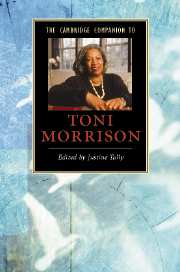10 - Toni Morrison, editor and teacher
from Part II - Toni Morrison’s criticism and editing
Published online by Cambridge University Press: 28 January 2008
Summary
Toni Morrison has described writing as the work she could not live without, but she has also expressed the “huge joy” she took in her work as an editor. She edited a range of books, fiction and non-fiction, poetry and prose, on subjects ranging from abortion rights to reparations. But she took particular pride in what she called her contribution to “the shelf,” that is, to the tradition of African American literature. She believed that her presence in the offices of Random House, where she served as senior editor from 1970 to 1988, assured the black author who walked through the door “that he doesn't have to explain everything - somebody is going to understand what he's trying to do, in his terms, not in somebody else's, but in his.” Among the writers to whom she conveyed this assurance were Toni Cade Bambara, Wesley Brown, Lucille Clifton, Leon Forrest, Gayl Jones, Nettie Jones, June Jordan, John McCluskey, and Quincy Troupe. No other editor before Morrison or since has boasted a comparable list of African American writers. As an editor, she helped to define two decades of African American literary history.
Although they do not share a common aesthetics the writers on Morrison's roster share a common sensibility which is preoccupied with “the kind of information you can find between the lines of history. It sort of falls off the page, or it's a glance and a reference. It's right there in the intersection where an institution becomes personal, where the historical becomes people with names.” Whether it is Bambara's description of the Harlem woman who arranges a field trip for the children on her block to the Fifth Avenue toy store F. A. O. Schwarz to teach them a lesson about race and class, or Brown's account of the “tragic magic,” the cool machismo of young black urban men that both preserves their selfhood and dooms them to violent deaths, they reveal cultures and communities observed with care from the inside.
- Type
- Chapter
- Information
- The Cambridge Companion to Toni Morrison , pp. 139 - 148Publisher: Cambridge University PressPrint publication year: 2007
- 21
- Cited by

